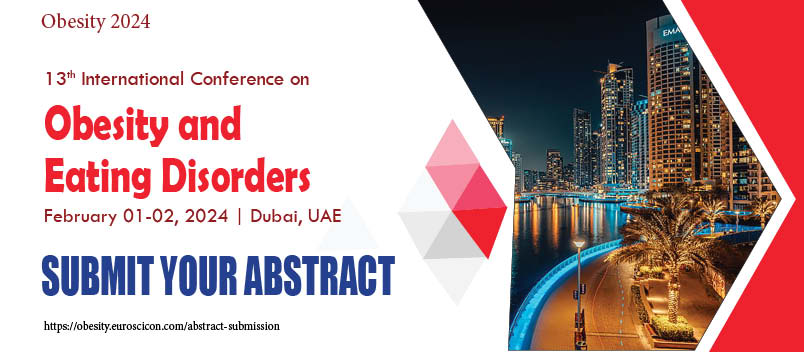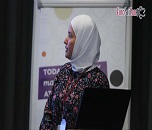Obesity-2024
ABOUT CONFERENCE
In continuation to successful past scientific meetings, 13th International Conference on Obesity and Eating Disorders will be held on February 01-02, 2024 Scheduled at Dubai, UAE. On behalf of Obesity-2024 Organizing Committee, we are pleased to invite Academics, Counselors, Clinicians, Diabetologists, Educators, Dieticians, Exercise Therapists, Family Physicians, Family Therapists, General Practitioners, Health educators/promoters, Healthcare policy makers, Mental Health professionals, Nurses, Nutritionists, Occupational Therapists, Pediatricians, Physical activity specialists, Physical Therapists, Physicians, Physiotherapists, Psychiatrists, Psychologists, Research scientists, Self-help group facilitators, Social workers, Teachers, Business delegates and Young researchers across the world to 13th European Congress on Obesity which is to be held on February 01-02, 2024 at Dubai, UAE. The conference highlights the theme “Connecting Minds, Healing Bodies: A Conference on Obesity and Eating Disorders". EuroScicon is the longest running independent life science events company with a predominantly academic client base. Our multi-professional and multi-specialty approach creates a unique experience that cannot be found with a specialist society or commercially.
Euroscicon are corporate members of the following organizations
- Royal Society of Biology
- British Society for Immunology
Conference Topics
- Obesity and Weight Management
- Obesity Causes
- Obesity and Eating Disorder
- Anti-Obesity Drugs
- Diet & Nutrition
- Dietary and Lifestyle Changes
- Obesity & Associated Health Disorders
- Obesity and Metabolic Diseases
- Obesity & Cancer
- Diabetes, Endocrinology and Obesity
- Gynecology & Obstetrics
- Advanced Treatment for Obesity
- Non-Surgical Treatment for Obesity
- Obesity Prevention
- Bariatric Surgery
- Obesity in Women
- Current Research on Obesity
- Childhood Obesity and Nutrition
- Obesity and Chronic Diseases
- Obesity and Weight Loss
- Genetics and Epigenetics of Obesity
- Blackburn Course in Obesity Medicine
- Hyperalimentation and Obesity
- Physical activity; Exercise & Kinesiology
- Yoga and Naturopathy
- Obesity and Cardiovascular Diseases
- Liposuction and Weight Loss Treatments
- Role of Steroids and Hormones in Obesity
- Obesity in Animals
- Clinical Obesity
- Obesity Inequalities
Sessions & Tracks
Track-01: Obesity and Weight Management
- Natural Weight Loss
- Therapies for Weight Loss
- Medications for Weight Loss
- Prevention of Obesity
- Herbal Weight Loss Medication
- Weight Management of Prediabetes
- Weight Management for Youth
- Dietary Supplements
Role of Exercises in the Weight Management
Obesity is a complex disease concerning an extreme quantity of body fat. Obesity is a medical problem that surges your risk of additional diseases and health glitches, such as high blood pressure, heart disease, diabetes, and certain cancers. Typically, obesity outcomes from a blend of inherited factors, collective with the environment, individual diet and exercise choices. Dietetic changes, increased physical movement and behavior changes can help you drop weight. Prescription medications and weight-loss procedures are additional possibilities for treating obesity.
Track-02: Obesity Causes
- Lipid and Glucose Metabolism
- Anabolic Steroids
- Exogenous Obesity
- Genetic Susceptibility
- Dietary Effects
- Risks of Chronic Diseases Development
- Hypertension and Hypothyroidism
- Size Acceptance and Patient Stories
The utmost common causes of obesity are overeating and lack of physical activity. Obesity is also associated with the foremost causes of death in the United States and around globe, including heart disease, stroke, diabetes and cancers of different types.
Track-03: Obesity and Eating Disorder
Obesity and eating disorders are each allied with severe physical and mental health consequences, and entities with obesity as well as comorbid eating disorders are at greater risk of these than individuals with whichever condition unaccompanied. Furthermore, obesity can contribute to eating disorder behaviors and vice-versa. Here are some of the eating disorders:
- Anorexia nervosa
- Bulimia nervosa
- Binge eating disorder
- Pica
- Rumination disorder
- Avoidant/restrictive food intake disorder
Track-04: Anti-Obesity Drugs
Anti-obesity drugs/medication is used as pharmacological mediators which lessen or control weight. These drugs alter one of the essential processes of the human body or weight regulation by changing either appetite or absorption of calories. The treatment for obese individuals and overweight is controlling diet and more physical activity. The idyllic anti-obesity drug would produce continued weight loss with negligible side effects. The mechanisms that control energy balance have substantial built-in is sacking, overlap significantly with other physiological functions, and are prejudiced by social and psychological factors that bound the efficiency of pharmacological happening.
Track-05: Diet & Nutrition
- Low Density Lipoproteins
- Fat Burning Foods
- Atkins Diet for Obese People
- Consuming Fresh Fruits & Vegetables
- Dietary Approaches for Weight Loss
- Diet & Weight Management
- Vitamins for Weight Loss
- Calorie counting
- Macronutrients and Micronutrients
A controlled eating routine gives the body essential nutrition. The necessities for a controlled eating routine can be met from an arrangement of plant and animal-based nutrition. A smart diet routine gives the essential vitality and nourishment without triggering any hazardous effects and additional weight gain from consuming more food stuff than required by the body. Accustomed eating routine and wholesome nourishment help in weakening the dangers of different endless issue like obesity, heart disease, stroke, malignancy, hypertension, diabetes and cancers of different types.
Track-06: Dietary and Lifestyle Changes
- Losing Weight: Lifestyle Changes
- Heart Disease and Diet and Lifestyle Changes
- Prevention of Chronic Disease
- Lifestyle Intervention
- Intensive Lifestyle Change
- Interventions to Promote Physical Activity and Dietary Lifestyle
- Meal Replacement Programs
- Physical Activity for Weight Loss
- Behavioral Therapy for Weight Loss
- Overall Balanced and Healthy Lifestyle
Lifestyle changes persist the backbone of treatment and are significant for the long period maintenance of weight loss. Regrettably, obesity is a chronic disorder and there is no ‘quick fix’ result or treatment that is effective for all obese individuals. Additionally, after subsequent weight loss programs, setbacks of weight gain are tremendously common. This highlights the importance of a lifetime vow to healthy eating and exercise practices. A variety of different treatment choices are accessible for obesity. Lifestyle alteration is vital in all treatment strategies. There are presently no long-term treatment programs that do not necessitate at least some lifestyle changes. Positive changes in your eating and exercise behaviour are vital for continued drop in weight. However, if extremely overweight it may be recommended to also take weight loss medications or undergo bariatric surgery
Track-07: Obesity & Associated Health Disorders
Overweight and obesity may increase the risk of many health problems, including diabetes, heart disease, and certain cancers. If you are pregnant, excess weight may lead to short- and long-term health problems for you and your child. Excess weight may increase the risk for many health problems, including
- Heart disease and stroke
- High blood pressure
- Diabetes
- Oncological Disorders
- Gallbladder disease and gallstones
- Osteoarthritis
- Gout
- Kidney Disease
- Breathing problems, such as sleep apnea and asthma
- Pregnancy problems such as high blood sugar throughout pregnancy, high blood pressure, and bigger risk for cesarean delivery
Track-08: Obesity & Cancer
- Esophageal Adenocarcinoma
- Liver and Kidney Cancer
- Multiple Myeloma
- Meningioma
- Pancreatic and Colorectal Cancer
- Gallbladder Cancer
- Breast, Endometrial and Ovarian Cancer
- Thyroid Cancer
The connection between obesity and cancer risk is clear. An Investigation confirms that excess body fat raises your risk for several cancers, including pancreatic, esophageal, kidney, colorectal, uterine, post-menopausal and breast cancers. What’s less clear is precisely how being obese rises that risk. Experts believe it’s mostly due to the inflammation caused by visceral fat – the fat that surrounds your vital organs. The problem with disproportionate visceral fat is that it disturbs certain processes in your body. This comprises how your body manages hormones, like insulin and estrogen.
Track-09: Diabetes, Endocrinology and Obesity
- Genomics, Type 2 Diabetes and Obesity
- Diabetes and Metabolic Disorders
- Diabetic Nephropathy and Urine
- Diabetic Retinopathy
- Clinical Researches in Diabetes
- Neuro Endocrinology
- Endocrine Diseases and Regulation
- Obesity & Leptin
- Obesity on Growth Hormone
- Adrenal and Pituitary Tumors
- Paediatric Endocrinology
- Current Advances in Endocrinology Metabolism
Obesity is vastly linked with several Endocrine System Diseases that are categorized by hormonal imbalance and/or resistance. Weight loss usually regularizes these endocrine alterations, associating obesity as a direct cause. Endocrinology and Metabolic Syndrome are the leading causes of mortality and morbidity all around the globe. In specific, the current epidemic of obesity is leading to early death through diabetes, cardiovascular disease and an increased prevalence of cancer.
Track-10: Obesity and Metabolic Diseases
- Abdominal Obesity
- High Triglyceride Levels
- High Blood Pressure
- Cholesterol Levels
- Insulin Resistance
- Polycystic Ovary Syndrome
- Diabetes Mellitus
- Impaired Glucose Tolerance
- Impaired Fasting Glucose
A diet high in unhealthy fats, calories and sugars along with an absence of systematic physical activity can definitely contribute to the risk factors for metabolic syndrome. Overweight people have a tendency to develop a resistance to insulin - a hormone that controls blood sugar levels, pushing sugar into the body's cells, where it is used for energy. When you're impervious to insulin, blood sugar isn't efficiently transported into the cells. That leads to high blood-sugar levels in the bloodstream, which is one of the symptoms of type 2 diabetes.
Track-11: Gynecology & Obstetrics
- Ovarian Cysts and Polycystic Ovarian Syndrome
- Gynoid Obesity
- Premature Birth
- Overdue pregnancy
- Macrosomia
- Archives of Gynecology and Obstetrics
Obesity during pregnancy is linked with increased maternal and fetal risks, which is inversely interrelated with the severity level of obesity. Other comorbidities are mutual (diabetes mellitus, hypertensive disorders, etc.) and subsidize to an even amplified risk. Maternal obesity during pregnancy subsidizes also to offspring obesity and noncommunicable diseases later in life in a vicious cycle. Managing these problems, and potentially reducing their risk, can pose a challenge in obstetric care. It is important to provide preconception nutritional and exercise care, and guidance during pregnancy and post pregnancy for appropriate weight loss.
Track-12: Advanced Treatment for Obesity
- Bariatric Surgery
- Liposuction
- Gastric Bypass Surgery
- Morbid Obesity Treatment
- Islet Cell Transplantation
- Weight Loss Using Kinesiology
Obesity is a key health problem around the globe and has reached an epidemic percentage in the Western world. Evidence remains to accumulate that obesity is a major hazard factor for many diseases and is connected with substantial morbidity and mortality. Surgery on the stomach and intestines to aid a person with extreme weight loss. Bariatric surgery is an opportunity for people who have a Body Mass Index above 40. Surgery is also a choice for people with a body mass index between 35 and 40 who have health glitches like heart diseases and type 2 diabetes.
- Adjustable Gastric Banding
- Roux-en-Y Gastric Bypass Surgery
- Vertical Sleeve Gastrostomy
Track-13: Non-Surgical Treatment for Obesity
Non-surgical treatment mainly comprises nutritional counseling with or without practice of supplements to improve the weight loss program. Management by supplements and nutrition being the pillars of weight loss and is extremely individualistic. A sensible goal for weight-loss in the setting of a nutrition-based treatment program is almost 1.0 -1.5 kg/wk. The concept that the weight-loss goal for each subject must be personalized and cannot be unilaterally based on usual weight-for-height diet norms are fetching progressively deceptive. One must reflect the family's weight, as well as the patient's weight and cultural, ethnical and racial context in setting personalized nutritional goals of weight loss. Lifestyle changes and regular exercise makes successful and lasting weight loss.
Track-14: Obesity Prevention
- Behavioral Therapy
- Fitness and Eating Plan
- Avoiding Junk Foods
- Monitoring weight in Regular Intervals
Obesity is a public health concern that has developed as epidemic worldwide. Extensive literature has arisen to show that overweight and obesity are major causes of co-morbidities, including cardiovascular diseases, type II diabetes, different types of cancers and many other health problems, which can lead to additional morbidity and mortality. The interrelated health care costs are also significant. Therefore, a public health tactic to progress population-based approaches for the prevention of excess weight gain is of great importance. However, public health intervention programs have had limited success in undertaking the increasing occurrence of obesity.
Track-15: Bariatric Surgery
- Weight Loss Surgery
- Types of Bariatric Surgery
- Bariatric Surgery Benefits and Side Effects
- Post Bariatric Surgery Diet
- Clinical Trials on Bariatric Surgery
Bariatric surgical procedure causes weight loss by limiting the quantity of food the stomach can hold, causing malabsorption of nutrients, or by a blend of both gastric restraint and malabsorption. Bariatric procedures also habitually cause hormonal changes. Most weight loss surgeries now-a-days are performed using negligibly invasive techniques like laparoscopic surgery.
The most common bariatric surgery procedures are sleeve gastrectomy, gastric bypass, biliopancreatic diversion with duodenal switch and adjustable gastric band. Each surgery has its own benefits and side effects.
Track-16: Obesity in Women
Adiposity has precise consequences for women and for reproductive health. Obesity in women is linked with variations in the reproductive cycle with a drop in fertility, as well as a bigger risk of polycystic ovarian syndrome and sporadic or no ovulation. Overweight women with PCOS have a inclination towards insulin resistance and are susceptible to develop diabetes, mainly in future. All these concerns make the treatment of infertility more complex and less fruitful. Additionally, the inclination toward menstrual and ovarian disorders related with obesity may predispose to an bigger risk of ovarian, endometrial and breast cancer. In fact, it is now clear prevalence of all gynecological cancer rises with rise in BMI.
Track-17: Current Research on Obesity
- Probiotics for Human Health
- Transplantation for Diabetic Patients
- Drug Treatments and Devices
- Early Diagnosis
- Use of Nanotechnology
Obesity amongst adults has increased in the United States. The newest data from the National Centre for Health Statistics states that 33% of population of 20 years age and more stable, more than 100 million people are strong. This development is not limited to adults but instead, has in like manner exaggerated adolescents. Amongst youth, 18% of children developed 6-11 years and 21% of adolescents developed 12– 19 years are seen as obese. These rates of obesity have dangerous consequences for Americans' wealth. But one of the national prosperities aims for the year 2021 is to reduce the consistency of obesity among adults by 10%, contemporary data displays that the condition isn't progressing. Hopkins GIM workers are beholding at overweight the full extent of its trademark history and challenges, and likewise endeavoring to combat the torment by inspecting different techniques and interventions
Track-18: Childhood Obesity and Nutrition
Childhood obesity is a complex disorder. Its occurrence has raised so significantly in recent centuries that many ponder it a key health concern of the developed world. The National Health and Nutrition Examination Survey specify that the occurrence of obesity is growing in all pediatric age groups, in both genders, and in various ethnic and racial groups.
Dietary practice in these perilous periods affects cognitive and physical development and has significances in future. Therefore, attaining healthy eating manners that will tolerate is important for children and adolescents. Nutrition management has been pragmatic to several childhood obesity intervention studies.
Track-19: Obesity and Chronic Diseases
Obesity is a chronic disease with a multifactorial etiology including genetics, environment, lifestyle, metabolism and behavioral components. A chronic disease treatment model involving both lifestyle interventions and, when appropriate, extra medicinal therapies carried by an interdisciplinary crew including exercise specialists, dietitians, physicians and behavior counsellors proposals the best chance for effective obesity treatment. Lifestyle aspects such as regular physical activity, proper nutrition and changes in eating behaviors should be synchronized.
Below are few diseases where obesity is showing to play a role.
- Various Cancers
- Type 2 Diabetes
- Cardiovascular Diseases
- Neurological Degeneration
- Stroke
- Hypertension
- Chronic Kidney Disease
- Anemia
Track-20: Obesity and Weight Loss
Effective weight loss behaviors comprise setting goals and making lifestyle variations, such as eating less calories and being physically energetic.
Eat Healthy: Weight loss supplements give your body the nutrients it needs on daily basis. It has sufficient calories for good health, but not several that you gain weight. A healthy eating plan is low in trans-fat, saturated fat, sodium, cholesterol and additional sugar. Following a healthy eating plan will lesser your risk for heart disease and other circumstances. Healthy foods include:
- Adequate amount of fruit and vegetables.
- Sufficient whole grains and starchy foods.
- Milk, Fat-free and low-fat dairy products
- Eggs, beans, meat, fish, and other non-dairy sources of protein.
- Small amounts of food and drinks that are high in fat and sugar
Track-21: Genetics and Epigenetics of Obesity
- Genetic Syndromes
- Epigenetics
- Hereditary Factors
- Genetic Mutations
- Global Methylation and Obesity
- Monogenic Obesity
- Syndromic Obesity
Obesity is a complex, inherited attribute influenced by the interchange of genetics, metagenomics, epigenetics and the environment. With the growing access to high precision analytical tools for genetic researches, numerous genes manipulating the phenotype have been recognized, particularly in initial onset severe obesity. The role and potential mechanism of epigenetic fluctuations that may be involved as mediators of the environmental impacts and that may provide future opportunities for intervention
Track-22: Blackburn Course in Obesity Medicine
The Blackburn Course in Obesity Medicine covers topics such as:
- Building and upholding a effective Obesity Medicine practice
- All-inclusive estimation of the patient with obesity
- Effective counseling and motivation techniques
- Evolving precision medicine approaches to obesity and metabolic disorders
- Evolving strategies and therapies for genetic obesity
- Enhancing communication about obesity with patients, payers, referring providers and public
- Medical and surgical treatment of children, adolescents and adults with obesity
- Medical management of the patient with obesity
- Steering our understanding of how diet influences metabolic processes
- Enhancing medical outcomes after bariatric surgery
Track-23: Hyperalimentation and Obesity
Hyperalimentation refers to a state where measures of food consumed are superior to appropriate. It embraces overeating and parenteral nutrition. The term can also be castoff to designate ingestion to reimburse for past nutritional insufficiencies. In this context, it can refer to parenteral nutrition, though this has been described as incorrect. This is a process in which vitamins and nutrients are given to a person in liquid form intravenously. It is a medical technique used for individuals who cannot get nutrients from food. This is done primarily due to weakened gastrointestinal conditions such as progressed eating disorders, severe malabsorption, polyphagia associated with diabetes.
To stop overeating pay attention to your portion sizes and avoid processed foods.
- Overnutrition
- Hyperalimentation
- Overconsumption of nutrients and food
- Normal growth, development and metabolism
- Overnutrition and related disorders
- Oversupplying a specific nutrient
- Iron poisoning
- Low sodium diet
- Nutrition intervention goals
- Food consumption
Track-24: Physical activity; Exercise & Kinesiology
Exercise physiology is a sub-teach of kinesiology that inclines to the momentary natural reactions to the stress of physical activity and how the body adjusts to repeated episodes of physical movement after some time. In that capacity, practice physiology experts often have the compulsion of beading a man to a larger amount of wellness or potentially well-being while, in the meantime, monitoring safety issues related to a solitary session of activity. The kind of client that can turnover by concocting under an activity physiology skillful differs extremely, spreading from world class competitors wishing to improve their execution to patients with ceaseless ailments wishing to increment or keep up their capacity to fulfill exercises of daily living.
Track-25: Yoga and Naturopathy
Unmanaged chronic disease or stress can have detrimental effects on the physical and psychological health of people like obesity, endocrine diseases, hormonal disorders and diabetes. Many of us start yoga due to depression, hypertension, a heart condition, drug abuse, obesity, and gastrointestinal disorders. Through yoga, people are drastically varying within the health system. Fitness program and diet should be strategic for regulating overweight, which is science-based and correlated to yoga-specific asana, breathing exercise, cardio exercise and prescribed meditation.
Ayurvedic medications are harmless and holistic methods for the administration of overweight with no side effects. Naturopathic medicine is well-defined as a drugless, rational and evidence-based system of drugs reporting treatments with natural elements buoyed by the concepts of toxemia vivacity and remedial capacity of the body.
Track-26: Obesity and Cardiovascular Diseases
Obesity upsurges the risk of developing cardiovascular disease, predominantly heart failure and coronary heart disease. The mechanisms through which obesity upsurges cardiovascular diseases hazard comprise deviations in body composition that may distress hemodynamics and varies heart structure. Pro-inflammatory cytokines formed by the adipose tissue can persuade cardiac dysfunction and can endorse the formation of atherosclerotic plaques.
Track-27: Liposuction and Weight Loss Treatments
Liposuction is a cosmetic process that eradicates fat that you can’t seem to get rid of through diet and exercise. A plastic or dermatologic surgeon typically does the technique on your hips, thighs, buttocks, belly, arms, back and underneath the face or chin to progress their shape. But liposuction can also be done with other plastic surgeries together with breast reductions, facelifts and tummy tucks.
Common treatments for overweight and obesity embrace losing weight over healthy eating, being more physically dynamic, and making other variations to your typical habits. Weight-management programs may assist few people lose weight or keep from regaining lost weight. Some people who have obesity are incapable to lose sufficient weight to progress their health or are impotent to keep from regaining weight. In those cases, a specialist may contemplate accumulating other treatments, together with weight-loss medicines, weight-loss devices or bariatric surgery
Track-28: Role of Steroids and Hormones in Obesity
Sex steroid hormones are concerned with the metabolism, accretion as well as the circulation of adipose tissues. Current studies expose that progesterone, estrogen and androgen receptor exist in adipose tissues consequently, and their activities could be direct. Sex steroid hormones transfer out their function in adipose tissues by both nongenomic and genomic mechanisms.
Track-29: Obesity in Animals
The problem of obesity isn't limited to just humans. The worldwide occurrence of pet obesity lies between 22% and 44%, and rates appear to be increasing.
Pet Obesity is connected with somber health circumstances, together with the following:
- Metabolic abnormalities
- Endocrinopathies
- Functional alterations such as decreased immune functions and joint disorders
- Cardiovascular disease
Track-30: Clinical Obesity
Obesity can be accompanying with numerous endocrine variations arising as a result of changes in the hypothalamic-pituitary hormones axes. These include hypothyroidism, hypogonadism, Cushing’s disease and growth hormone shortage. Adipose tissue has many other vital functions that can be mediated through hormones or constituents produced and released by adipocytes which comprise Leptin and adiponectin. Hypothyroidism is a communal clinical problem seen in obese patients and could subsidize to the presence of symptoms such as weakness and inability to focus. Hypogonadism and growth hormone shortages are both connected with abdominal obesity. The treatment of these two conditions can outcome in improving conditioning, muscle strength, and stamina in weight loss, better-quality metabolic profile, and enhanced bone density.
Track-31: Obesity Inequalities
Socioeconomic inequalities in obesity were analyzed using simple measures of group differences (prevalence difference [PD], prevalence ratio [PR]) and complex summary measures of inequality (slope index of inequality [SII], relative index of inequality [RII]). PDs and SIIs quantify the magnitude of absolute inequality, and PRs and RIIs represent the magnitude of relative inequality. Selective use of exclusively absolute or relative measures of inequality can lead to a biased assessment of increasing or decreasing health inequalities over time; thus it is recommended that both be considered when possible
- Obesity Epidemic
- Obesity Prevalence
- Weighting Factors
- Socioeconomic Spectrum
- Inequalities In Obesity
- Global Methylation And Obesity
- Prenatal And Early Life Influences
- Dietary Behaviors
- Physical Fitness
- Prolonged Financial Stress
- Physical Determinants Of Obesity
- Overweight And Obesity
- Early Diagnosis
Market Analysis
Synopsis: Obesity is the abnormal or excessive fat accumulation that presents a risk to health. A body mass index (BMI) over 25 is considered overweight, and over 30 is obese. The obesity-2023 market is expected to grow with a CAGR of 5.1%, from USD 828.71 million in 2022 to USD 1362.80 million by 2032.
MARKET ANALYSIS
Obesity management Market is required to achieve US$ 6.2 billion by 2022 from US$ 4.17 billion of every 2021. Notwithstanding, a few symptoms of medications, administrative issues, and mind-boggling expense are the significant restrictions for the market.
The extraordinary requirement for inside and out comprehension of the "Obesity Management Market- Forecast to 2022″ combined with its high development potential required the improvement of this report by Market Research Future. The report particularly centers around the key business improvement patterns and powers that shape the market, yet not constrained to just business nature, but rather which incorporates a wide range, for example, social, mechanical and others.
Contingent upon the geographic district, Obesity Management Market is portioned into four key locales: Americas, Europe, Asia-Pacific, and the Middle East and Africa. Thinking about the worldwide situation of the market, North America include the biggest piece of the overall industry in worldwide Obesity Management Market. In addition, the European market is additionally developing constantly. Then again, Asia-Pacific market is required to develop at the critical rate in the Obesity Management Market section amid the guage period. Rest of the World is probably going to have a constrained however relentless development in the market.
Heftiness administration Market has been portioned based on Prescription weight reduction drug which includes orlistat (Xenical), lorcaserin (Belviq), phentermine and topiramate (Qsymia), bupropion and naltrexone (Contrave), and liraglutide (Saxenda), and others. Based on Surgery it divided into Gastric sidestep medical procedure, Laparoscopic flexible gastric banding (LAGB), Biliopancreatic preoccupation with duodenal switch, and others. Based on the way life transforms, it is divided into Dietary changes, Exercise, and others.
The report for Obesity Management Market of Market Research Future involves broad essential research alongside the nitty gritty investigation of subjective and additionally quantitative viewpoints by different industry specialists, key supposition pioneers to pick up the more profound understanding of the market and industry execution. The report gives the reasonable picture of the current market situation which incorporates authentic and anticipated market estimate as far as esteem and volume, mechanical headway, full-scale conservative and representing factors in the market. The report gives subtle elements of data and systems of the best key players in the business. The report likewise gives an expansive investigation of the diverse markets fragments and districts.
Worldwide Obesity Management Market Players:
There are a lot of vast and little market players which work in this market everywhere throughout the globe are Pfizer Inc.(US), Merck Sharp and Dohme Corp., a backup of Merck and Co., Inc.(US), F. Hoffmann-La Roche Ltd (Switzerland), GlaxoSmithKline plc. (UK), AstraZeneca (UK), Herbalife Ltd. (U.S.), Apollo Endosurgery (U.S.), Ethicon, Inc. (U.S.)
The Global Obesity Management Market has been assessed as consistently developing the business sector and it is normal that the market will keep on growing correspondingly sooner rather than later. Stoutness happens because of vitality unevenness between calories admission and calories expended. Weight influences well-being and can prompt different infections like heart ailments, stroke, diabetes, hypertension and so forth. Changing the way of life, for example, eating lousy nourishment or vitality thick sustenance that is the high level of fat, the low physical movement is the main considerations that prompt weight. The number of inhabitants in corpulent individuals has multiplied since 1980. As indicated by the World Health Organization (WHO), in 2014, in excess of 1.9 billion grown-ups, 18 years and more seasoned, were overweight. Out of these more than 600 million were stout and around 39% of grown-ups were underweight and out of this 13 % were corpulent. The vast majority of the nations of the World are confronting the issue of weight. Prior high pay nations were confronting the issue of heftiness and overweight however now issue of stoutness is on ascend in low and center salary nations. Corpulence can be anticipated by some dietary changes and exercise. Shoppers are winding up more cognizant about their wellbeing which is driving the development for the corpulence administration showcase. Medications makers' burning through cash in R&D to grow new medications and supplements. Human services arrangement supplier organizations are likewise giving development answers for doctor's facilities. Worldwide Obesity Management Market was about US$ 4.17 billion of every 2015 and is required to achieve US$ 6.2 billion by 2022 at a CAGR of 8.2%.
With a total market share of more than 63.0% in 2021, the United States is expected to maintain a high growth rate throughout the forecast period. Obesity is a major health issue in the country, resulting in a variety of diseases.
North America is expected to generate significant revenue in the obesity management market in the coming years. Factors like a high population awareness, the presence of prominent drug manufacturers, and the rising prevalence of obesity account for the region's rapid growth in the obesity management market.
The bupropion and naltrexone segment leads the North American obesity management market and is likely to sustain its lead, making it highly appealing to stakeholders.
Europe contributes significantly to the obesity management market's revenue. Obesity in the region is exacerbated by high intake of processed meats and a high prevalence of lifestyle diseases. The availability of obesity management health programmes and government-led obesity management health centres bodes well for the region's obesity management market growth.
Asia Pacific is rapidly emerging as a key market for obesity management. Obesity management programmes have emerged as a result of the region's developing countries' excessive rise in obesity incidence as a result of changing lifestyle. This fuels the regional obesity management market.
Propensity for Obesity Management Growth in India
India dominates the South Asian market with a market share of 60.9% and is expected to grow at a CAGR of 4.8%. Rising healthcare expenditures are expected to strengthen the country's market.
Obesity among adults is expected to triple between 2010 and 2040, with an estimated 30% of the population being overweight by that time. Obesity is increasing in the country due to increased consumption of energy-dense foods, sedentary lifestyle, a lack of health care services, and an inadequate financial support.
Germany's Key Growth Enabling Factors
Germany will hold 17.6% of the European obesity management market in 2021. The Robert Koch Institute reports that 67% of adults in Germany are overweight. Germany has a significant problem with high cholesterol and type 1 diabetes.
The German federal government is enacting policies to combat the country's growing obesity problem. In addition, the number of anti-obesity clinics in the country has increased. These factors will contribute to the expansion of obesity management in the country.
With a market value of US$ 36.6 Mn in 2021, Russia occupies an important financially rewarding position in Europe. Since 2014, the number of Russians diagnosed with obesity has increased by nearly 50%. According to the WHO, more than 60% of Russians are overweight, with 20% being obese.
The Russian Health Ministry is constantly striving to create strategies for enhancing the population's overall health. According to the World Factbook, the prevalence of adult obesity in Russia is 23.1%.
The Growth Potential in China's Obesity Management Market
The obesity management market in China is growing at a CAGR of 4.3% and is expected to account for more than 42% of the East Asian market over the forecast period. According to national survey data, more than half of all Chinese adults are now overweight or obese.
Rapid economic growth in the country in recent decades has resulted in significant changes in lifestyle, diet, and exercise habits. According to the National Health Commission report from 2020, more than half of adults are classified as overweight, with 16.4% being obese.





















